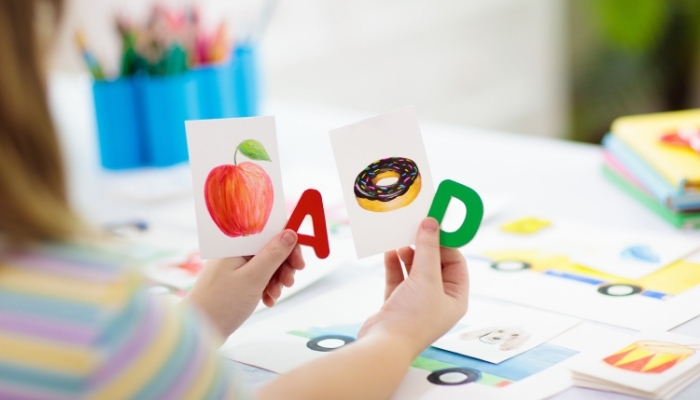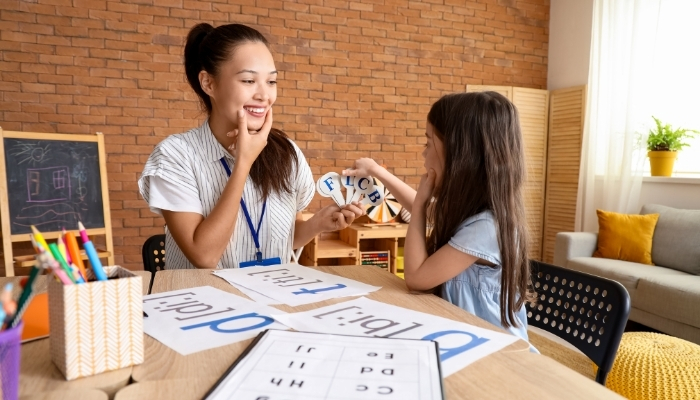You've probably heard teachers mention phonics and phonemic awareness during parent conferences. Maybe you nodded along, but secretly wondered what these terms actually mean for your child. You're not alone in feeling confused about these concepts.
Many parents worry they're missing something crucial for their child's reading development. The good news is that understanding these two skills can actually simplify how you support your little reader at home. Both phonics and phonemic awareness work together to build strong reading foundations, but they develop through different approaches.
This guide breaks down each concept in plain language and shows you practical ways to nurture these skills. You'll learn how to recognize the signs that your child is naturally developing these abilities.
Key Takeaways
-
Develop phonemic awareness first by letting your child explore and manipulate sounds before introducing letters.
-
Use phonics to connect sounds to letters and words, helping your child read independently and confidently.
-
Combine short, playful daily activities with real-life reading experiences to make learning a natural and enjoyable process.
-
Tailor activities to your child’s interests to keep them engaged and motivated throughout the learning process.
What is Phonics?
Phonics is the method by which children learn the connection between letters and the sounds they make. When your child sees the letter "B" and knows it makes the /b/ sound, they are using phonics. This helps children learn to read words by linking what they see on the page to the sounds they recognize.

For example, your child can sound out the word "cat" by saying each sound /k/ + /a/ + /t/ and then blending them together. Phonics provides children with the tools to read new words independently. Most programs start with simple letter sounds and gradually move to combinations like "sh" and "ch," helping children build confidence step by step.
What is Phonemic Awareness?
Phonemic awareness is your child’s ability to notice and work with the sounds in spoken words. This skill happens through listening and speaking; it does not involve letters or writing.
For example, your child might hear that "dog" is composed of three separate sounds: /d/, /o/, and /g/, or change a word by swapping sounds, such as turning "cat" into "cap" by replacing /t/ with /p/.
Important Phonemic Awareness Skills:
-
Blending sounds: Putting individual sounds together to say a word, like /b/ + /a/ + /t/ → “bat.”
-
Breaking words apart: Splitting a word into its separate sounds, such as “frog” → /f/ /r/ /o/ /g/.
-
Changing sounds: Altering sounds to make new words, for instance, changing /m/ in “man” to /p/ → “pan.”
Practicing these skills helps children develop strong listening abilities, which are the building blocks for reading and spelling.
Phonics vs Phonemic Awareness: Key Differences
You may be tempted to use these terms interchangeably, which makes perfect sense since they both involve sounds and reading. However, recognizing their distinct roles can help you provide more effective support at home.
Here is a detailed difference table for your better understanding.
|
Aspect |
Phonics |
Phonemic Awareness |
|
Primary Focus |
Connects letters to sounds |
Works with sounds only |
|
Sensory/Component |
Visual – involves seeing letters and words |
Auditory – focuses on listening |
|
Teaching Method |
Uses written materials, books, and structured lessons |
Uses spoken words, games, rhymes, and sound activities |
|
Example Activity |
Sounding out “dog” as d-o-g |
Clapping syllables in “elephant” or blending /b/ + /a/ + /t/ → “bat” |
|
Typical Age to Start |
Around age 4–5 |
Can begin as early as age 3 |
|
Skill Developed |
Decoding written words |
Hearing, blending, and manipulating sounds |
|
Learning Goal |
Reading independently |
Developing sound awareness for reading and spelling |
Both skills support each other beautifully in building reading competence. Your child needs phonemic awareness to understand what phonics teaches, while phonics gives meaning to the sounds they can already manipulate.
Is Phonics, Phonemic Awareness, and Phonological Awareness the Same Thing?
These three terms describe different but related skills, and many parents wonder how they differ. Think of phonological awareness as the big umbrella that covers all the sound-related skills your child develops. It includes recognizing rhymes, counting syllables, and noticing beginning or ending sounds. For example, your child might clap along to the syllables in "elephant" or realize that "cat" and "bat" rhyme.

Phonemic awareness, on the other hand, focuses on the individual sounds that make up words. While your child might recognize that "elephant" has three syllables, phonemic awareness means they can break a word into separate sounds.
Phonics is slightly different because it connects these sound skills to written letters. Your child takes the sounds they hear and matches them to letters on the page to read and spell words.
To make it easier for you, here is an example of how the difference looks in practice.
-
When you ask, "What sound does 'dog' start with?" you’re helping your child build phonemic awareness.
-
If you show the letter "D" and ask, "What sound does this make?" you’re teaching phonics.
-
And if you help them notice that "dog," "duck," and "door" all start with the same sound, you’re strengthening broader phonological awareness.
Grasping the differences between phonics, phonemic awareness, and phonological awareness highlights how each contributes to reading success. With this understanding, let us examine how phonemic awareness and phonics interact.
How Phonemic Awareness and Phonics Work Together?
Phonemic awareness and phonics complement each other, making learning to read faster and easier for children. Phonemic awareness gives your child the ability to hear, identify, and manipulate individual sounds in words, while phonics teaches them how those sounds correspond to letters on the page. Together, they enable children to decode new words with confidence and accuracy.
This partnership works in several ways:
-
Connecting Sounds to Letters: Children who can recognize the sounds in a word, like /c/ /a/ /t/, can use phonics to match each sound to its letter.
-
Building Reading Fluency: Strong skills in both areas let children read words smoothly without pausing to figure out each letter or sound.
-
Supporting Spelling: Hearing and manipulating sounds helps children spell words correctly by linking sounds to letters.
-
Handling Unfamiliar Words: When children encounter new words, phonemic awareness enables them to break the word down into its individual sounds, and phonics helps them read it using the corresponding letters.
By developing both skills together, children gain the tools to become confident, independent readers.
Also Read: How to Improve Your Child’s Reading Skills
How to Teach Phonemic Awareness?
You can develop phonemic awareness through playful activities that focus on sounds rather than letters. These work beautifully during everyday moments and feel more like games than lessons for your child.

Below are the steps you can follow:
Step 1: Start with Sound Identification
Ask your child to listen for specific sounds in words during regular conversations. "Can you hear the /m/ sound in 'mommy'?" or "What sound do you hear at the beginning of 'sun'?" Keep these moments brief and celebrate every attempt, whether correct or not.
Step 2: Practice Sound Blending
Say individual sounds slowly and have your child blend them. Start with two-sound words like "go" (/g/ + /o/) before moving to three-sound words like "cat" (/k/ + /a/ + /t/). This skill directly supports their future reading development.
Step 3: Try Sound Segmentation
Help your child break familiar words into individual sounds. Start with their name or favorite things. "Let's count the sounds in 'dog' - /d/, /o/, /g/. That's three sounds!" Use your fingers to count each sound they identify.
Step 4: Play Rhyming Games
Create silly rhymes during car rides or while preparing dinner. "I see a cat wearing a hat who caught a rat." Your child learns to recognize similar ending sounds, which naturally builds phonemic awareness through repetition and fun.
Step 5: Use Sound Substitution
Once your child is comfortable with blending and segmenting, try changing one sound in a word to make a new one. For example, "What happens if we change the /k/ in 'cat' to /b/? Now we have 'bat'!" This shows how sounds work together in words, though it may take time for your child to master.
However, keep in mind that phonemic awareness develops gradually over time. Some children grasp these concepts quickly, while others require more practice; both patterns are entirely normal.
Also Read: Phonemic Awareness: Blending and Segmenting Techniques
How to Teach Phonics?
To teach phonics, try to make learning visual and hands-on. Children learn best when they can see, touch, and play with letters while hearing the sounds they make.
Here are some steps you can follow at home:
Step 1: Begin with Single Letter Sounds
Teach one letter sound at a time using consistent phrases. "This is the letter M. M makes the /m/ sound like in 'mouse.'" Show the letter, say the sound clearly, and give a familiar example word your child knows.
Step 2: Practice Letter Formation
Have your child trace letters in sand, write them in the air, or form them with playdough. This muscle memory approach helps many children remember both the shape of the letter and its corresponding sound.
Step 3: Use Decodable Books
Choose books that contain mostly the letter sounds your child has learned so far. This provides them with successful reading experiences and gradually builds their confidence. Start with simple three-letter words before progressing to longer patterns.
Step 4: Teach Common Letter Combinations
Once your child knows individual letter sounds, introduce frequent combinations, such as "sh," "ch," and "th." Practice these in simple words like "ship," "chip," and "thin" that your child can relate to.
Step 5: Play Word Building Games
Use letter tiles or magnetic letters to build words together. Start with "cat," then change the first letter to make "bat," "hat," and "rat." This demonstrates how phonics patterns concretely work across different words.
Step 6: Create Personal Sound-Symbol Connections
Help your child connect letters to meaningful words in their life. "Your name starts with the letter J, which makes the /j/ sound like 'jump.'" Personal connections often help learning stick better than abstract examples.
Phonics typically works best when lessons are kept short, positive, and connected to your child's interests and daily experiences.
Activities to Promote Phonics and Phonemic Awareness Skills in Kids
You can help your child build both skills through fun, hands-on activities that don’t feel like formal lessons. Select activities that align with your child's comfort level and interests. Try mixing things up to keep learning exciting and to encourage their natural curiosity.

10 Activities to Promote Phonics
-
Letter Sound Hunts: Walk around your house or neighborhood looking for objects that start with specific letter sounds. "Let's find five things that start with /b/ like 'book,' 'ball,' and 'banana.'" Take pictures to create your own family alphabet book over time.
-
Magnetic Letter Games: Use refrigerator magnets to spell simple words together. Start with three-letter words and let your child physically move letters to create new combinations. Change "dog" to "log" by switching just the first letter.
-
Sound Sorting Activities: Collect small objects or pictures and sort them by their beginning sounds. Put all the /t/ items in one container and the/s/ items in another. This reinforces letter-sound connections through hands-on practice that many children enjoy.
-
Word Family Wheels: Create simple wheels with common endings like "-at," "-ig," or "-un." Add different beginning letters to make new words. Your child can spin the wheel and read the combinations they create independently.
-
Letter Journals: Start a special notebook where your child draws or pastes pictures of items for each letter of the alphabet. Add discoveries throughout the week as you notice items together during regular activities and outings.
-
Phonics Scavenger Hunts: Give your child a specific letter and challenge them to find items around the house that start with that sound. Make it engaging by setting a gentle timer or seeing who can find more items.
-
Build-a-Word Station: Set up a permanent space with letter tiles, paper, and pencils where your child can practice building words anytime they feel interested. Rotate the available letters to focus on current learning goals.
-
Letter Detective Games: Read favorite books together and have your child spot specific letters on each page. "Can you find all the letter B's on this page?" This naturally connects phonics learning to real reading experiences.
-
Sound Substitution Practice: Write simple three-letter words and help your child change one letter at a time to create new words. Start with "cat" and work through "bat," "hat," "hot," "hop," and "pop" together.
-
Interactive Letter Apps: Utilize educational apps that enable children to trace letters while hearing their corresponding sounds. Select apps that offer gentle feedback and celebrate progress to maintain motivation without undue pressure.
10 Activities to Promote Phonemic Awareness
-
Clapping Syllable Games: Clap out the syllables in family members' names, favorite foods, or animals during regular conversations. "El-e-phant has three claps!" This builds awareness of sound units within words without requiring any knowledge of letters.
-
Sound Box Activities: Draw simple boxes representing each sound in a word. Say "cat" and have your child move a small object into each box for /k/, /a/, and /t/. This helps visualize the individual sounds within familiar words.
-
Rhyme Time Challenges: Take turns creating rhyming words during everyday moments like meals or car rides. Start with simple patterns like "cat, bat, hat" and let your child contribute whatever rhymes they notice.
-
First Sound Identification: During regular activities, name objects and ask your child to identify the first sound they hear. "What's the first sound in 'apple'?" Keep these moments conversational rather than feeling like formal testing.
-
Sound Deletion Games: Say a familiar word, then ask what remains when you remove a specific sound. "Say 'smile' without the /s/ sound." This advanced skill demonstrates mastery of sound manipulation, although many children require time to develop this ability.
-
Tongue Twister Fun: Share or create tongue twisters that emphasize specific sounds. "Sally sells seashells by the seashore" highlights the /s/ sound while building phonemic awareness through playful repetition.
-
Sound Matching Games: Collect pairs of objects that start with the same sound. Hide them around a room and have your child find the matching pairs. This reinforces beginning sound recognition through movement and discovery.
-
Beat the Sound Games: Use drums, pots, or rhythm sticks to beat out the individual sounds in words. Say "dog" and beat three times for /d/, /o/, /g/. This adds physical movement to sound awareness activities.
-
Mystery Sound Games: Make individual sounds and have your child guess what letter makes that sound, or think of words that contain it. Keep it playful with silly voices or interesting sound effects that make them giggle.
-
Phoneme Counting Activities: Give your child small objects, such as buttons or beans. Say a word and have them count out one object for each sound they hear. This makes abstract sound concepts more concrete and manageable.
These activities work most accurately when you keep them brief, positive, and connected to your child's daily experiences and current interests.
Also Read: Top 10 Phonological Awareness Games to Boost Kids’ Reading Skills
Tips for Teaching Phonics and Phonemic Awareness to Kids
Supporting your child's phonics and phonemic awareness development requires patience, consistency, and realistic expectations. Understanding what helps and what might hinder learning can make your efforts more effective and enjoyable.

Go through the practical tips and strategies given below, which you can use to support your child’s development.
-
Focus on Listening and Sound Play
Encourage your child to notice and play with the sounds in words through rhymes, alliteration, and simple sound games. This will help them hear, segment, and blend sounds, which is essential for reading.
-
Teach Letter-Sound Connections Clearly
When you introduce letters, always link them to their sounds. Practice identifying letters in isolation and in simple words so your child can connect what they hear to what they see in print.
-
Practice Blending and Segmenting Words
Guide your child to break words into individual sounds and then blend them back together. This will strengthen their decoding skills and prepare them for fluent reading.
-
Use Decodable Texts
Provide your child with reading materials that align with the phonics patterns they are learning. Decodable texts let them apply their knowledge immediately and reinforce learning through real reading.
-
Keep Activities Playful and Engaging
Turn learning into games whenever you can. Use songs, rhymes, movement, and multisensory activities to make phonics and phonemic awareness fun and memorable.
-
Match Activities to Your Child’s Interests
Incorporate topics your child loves, such as dinosaurs, superheroes, or animals, into phonics and sound games. This makes learning feel relevant and keeps them engaged.
-
Focus on Consistency Over Intensity
Short, daily practice sessions of 5 to 10 minutes are more effective than long, occasional sessions. Regular exposure helps your child internalize skills naturally and reduces frustration.
-
Celebrate Small Progress Along the Way
Acknowledge every bit of growth, no matter how small the improvement. Celebrating these wins will boost your child's confidence and motivate them to keep practicing.
-
Avoid Common Pitfalls That Create Frustration
Don’t rush through stages or compare your child to others. Some children require more time with phonemic awareness before phonics becomes comprehensible, and that is completely normal.
-
Stay Patient During Learning Plateaus
Understand that skills often develop in bursts rather than steadily. Your child may seem stuck for weeks, then suddenly make great progress. Keep supporting them consistently and gently.
-
Connect Learning to Everyday Experiences
Use phonics and phonemic awareness in everyday situations. Point out letters on signs, practice rhyming words during walks, or read together and highlight sounds. This helps your child apply skills naturally.
-
Know When to Seek Additional Support
If your child continues to struggle even after months of regular practice, consider reaching out to their teacher or enrolling them in an educational program, such as FunFox, for guided support. Early intervention can prevent reading difficulties, though many children simply need steady practice and time.
Always remember that your support and encouragement matter more than perfect technique or rapid progress. Children learn most successfully when they feel loved and supported throughout their learning journey.
Conclusion
Understanding phonics vs phonemic awareness helps you focus on the right activities at the right time to support your child’s reading journey. But sometimes, children need extra guidance beyond what you can provide at home. That’s where FunFox can help.
FunFox offers programs that strengthen both phonics and phonemic awareness in a fun and engaging way:
-
Writers Club – Builds phonemic awareness through creative writing activities that help children explore how sounds form words.
-
Readers Club – Practices phonics through interactive reading exercises and decodable texts, helping children apply letter-sound knowledge while reading.
-
Small-group instruction – Gives children personal attention and focuses on the skills they need most.
-
Interactive online sessions – Offer engaging, hands-on learning experiences from the comfort of your own home.
Give your child the strong reading foundation they deserve. Book a free trial class with FunFox today and support your child in becoming a confident reader.
FAQ’s
1. Which comes first, phonemic awareness or phonics?
Phonemic awareness comes first. Children develop the ability to hear, identify, and manipulate sounds before connecting them to letters. Strong auditory skills facilitate faster and more natural learning of phonics.
2. What is another name for phonics?
Phonics is also called letter-sound instruction or synthetic phonics. It focuses on teaching the relationships between letters and sounds to help children decode words and improve reading fluency.
3. What are the seven phonemic awareness skills?
The seven phonemic awareness skills include sound isolation, blending, segmenting, deletion, substitution, addition, and manipulation. Mastering these skills builds a child’s ability to hear and work with individual sounds.
4. What are the 7 phases of phonics?
The seven phonics phases typically include: letter-sound recognition, simple consonant-vowel-consonant words, consonant blends, digraphs, vowel digraphs and diphthongs, complex spelling patterns, and advanced word building for fluent reading.















